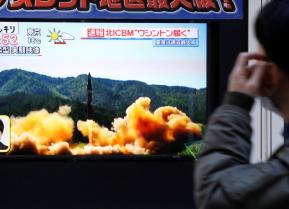Introducing Russia's New Au-50 Reconnaissance Aircraft: Here's What It Can Do
What we know.
Russia’s Beriev A-50U reconnaissance aircraft is rapidly moving along in serial production, according to the Beriev Aircraft Company.
"On December 6, the Beriev Aircraft Company delivered another A-50U serially modernized long-range radar surveillance plane (side number “red” 45) to the Aerospace Force of Russia. After passing all the necessary trials, the plane was transferred to an Aerospace Force crew and made a successful flight from Taganrog to the place of its permanent basing," the manufacturer announced earlier this month.
The A-50U is a modernization of the Soviet A-50, an Airborne Early Warning & Control (AEW&C) aircraft. One of the many Il-76 variants produced over the 1980s, the A-50 is equipped with a Liana surveillance radar system that enabled the live tracking of up to ten targets.
The A-50U’s major improvement is its new Shmel-M radar: "While upgrading the A-50U aircraft in order to improve its combat and flight characteristics, the Vega concern has modernized the on-board Shmel radar through the use of advanced software and hardware," announced a subsidiary of Rostec.
But what exactly is the new “advanced software and hardware” that the manufacturer is touting as a major advancement over the A-50’s tracking technology? The Shmel-M is a rotating, dome-shaped radar tracking system that gives the A-50U its characteristic appearance, often referred to as the “mushroom plane” within the Russian military.
While the design and dimensions of the A-50U are still based off the Il-76 and therefore remain largely unchanged from the A-50, the manufacturer claims that the radar dome itself is lighter due to the modern components of the Shmel-M. It is also more effective, with the ability to track air targets at a distance of up 650 km and ground targets at 300 km. It can track around 300 ground or forty air targets simultaneously.
The A-50U boasts a fully digitized system as opposed to the analog inputs of the A-50U, which makes it easier and faster to use while minimizing the risk of operator error. In the category of miscellaneous improvements, it contains a redesigned interior layout with a lavatory and rest area.
As with many of the recent additions to Russia’s aircraft lineup, the A-50U was deployed in Syria through 2018. Aside from the tangible research and development benefits of field testing, a modern AEW&C plane could have been helpful in Russia’s enforcement of its Northern Syrian “de-escalation zones” in the latter stage of the Syrian Civil War. The prior deployment of the original A-50 in Syria in 2015 gave the Russian Air Force a unique opportunity to compare the real-use performance of the 50 and 50U side by side.
The A-50U is similar to the U.S. Boeing E-3 Sentry in design in function, though it remains to be seen how the two compare in real performance. A specially produced export variant of the original A-50, the A-50I, was manufactured with the Israeli EL/W-2090 Phalcon radar and sold to India. There were also export talks with China in the early 2000s, but the negotiations broke down and Beijing went ahead with its domestically produced KJ-2000 AEW&C aircraft.
Given the Kremlin’s aggressive arms export strategy over the past decade, it seems exceedingly likely that India is being eyed as a prospective buyer for the A-50U as it moves along in its mass production.
Mark Episkopos is a frequent contributor to The National Interest and serves as a research assistant at the Center for the National Interest. Mark is also a Ph.D. student in History at American University.
Image: Wikipedia.


